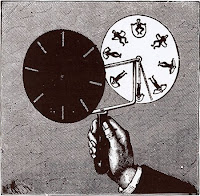
A phenakistoscope is an animation toy from the 1830s that takes flat artwork and turns it into a short animated movie.

You spin the disks and look through the slots, which act as a shutter. In a modern variation, the slots are on the artwork disk. You mount the disk on a pivot and spin the disk while looking through the slots into a mirror.
Here's a 12 frame phenakistoscope that I designed:
Right click on the image to download a 1600x1600 black and white version suitable for printing out.
Here's what the happy face looks like in motion, at 12 frames per second:

Each frame in the 12 frame phenakistoscope is rotated 30 degrees from the previous frame. It struck me that a snowflake makes very pretty flat artwork, with very nice hexagonal symmetry. That makes for a 6 frame phenakistoscope, with each frame rotated 60 degrees from the previous frame.

You can turn a snowflake into a phenakistoscope in your paint software. First, cut the snowflake out from its background, so that any color gradient won't rotate in the background. Then, duplicate the snowflake layer 5 times for a total of 6 layers. Rotate 5 of the layers to 60, 120, 180, 240, and 300 degrees from the original orientation. (You may have to use -120 and -60 degrees for the last two in programs like Photoshop that only allow rotations between -180 and 180 degrees.) Line up the snowflakes so that some feature(s) on all of them are in line - it might be the center point, or an inner hexagon, or one of the dendrites. Create a background and merge it with each of the six snowflake layers. Then output the image to a GIF animation and your snowflake will spin!

Details on the snowflakes seem to pulsate (animators call it "boiling") because snowflakes are never perfectly symmetrical. Here's a "furry" snowflake that shows this boiling even better:

I posted a movie of mine that features my phenakistocopes. Here it is:













